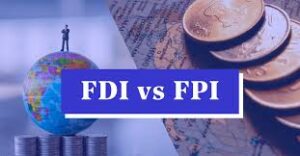FPI and FDI
Take a deep dive into FPI and FDI.
Both foreign portfolio investment (FPI) and foreign direct investment (FDI) are sources of international capital flows, but they differ significantly in their nature, objectives and effects. Here’s a detailed breakdown:
Foreign Portfolio Investment (FPI)
- Focus: Financial assets
- Stocks, bonds, mutual funds, ETFs of foreign companies
- American Depository Receipts (ADRs)/Global Depository Receipts (GDRs) – represent shares of foreign companies traded on a local exchange.
- Investment Style: unfunctional
- Investors do not actively manage foreign companies or assets.
- Time horizon: Short to medium term
- Investments are held for short term with the objective of capital appreciation and income generation.
- Liquidity: high
- Assets can be easily bought and sold on exchanges, providing quick access to funds.
- Advantages:
- Diversification: Reduces risk by spreading investments across different countries and markets.
- Growth potential: Emerging markets can offer higher returns.
- Currency Exposure: Potential benefits from foreign currency appreciation
- Risks:
- Currency Fluctuations: Depreciation of foreign currency reduces profitability.
- Political and Economic Risk: Unstable conditions can affect investment.
- Liquidity Risk: Less liquid foreign markets can make it difficult to sell.
Foreign Direct Investment (FDI)
- Focus: Real assets and control
- Establishing or acquiring a business entity in a foreign country
- Investing in physical assets such as property, plant, and machinery
- Investment Style: active
- Investors have a say in management decisions and actions.
- Time horizon: Long term
- Investments are held for the long term with a strategic focus on establishing a presence in foreign markets.

- Liquidity: less
- Exiting FDI can be complicated and time-consuming due to ownership stakes.
- Advantages:
- Market Access: Entering new markets and establishing a local brand
- Access to resources: access to raw materials, labor, or technology
- Increasing Efficiency: Economies of Scale and Production Optimization.
- Risks:
- Political and Economic Risk: High risk of political instability and currency fluctuations
- Repatriation Restrictions: Difficulty repatriating profits
- Management Challenges: Working in a different cultural and legal environment
Here is a table that summarizes the key differences:
| Feature | Foreign Portfolio Investment (FPI) | Foreign Direct Investment (FDI) |
|---|---|---|
| Type of investment | Financial assets | Real assets and control |
| Investment style | unfunctional | active |
| Time horizon | Short to medium term | Long term |
| Liquidity | high | less |
| Benefits | Diversification, growth potential, currency exposure | Market access, resource acquisition, efficiency enhancement |
| Risks | Currency fluctuations, political and economic risk, liquidity risk | Political and economic risk, repatriation restrictions, administrative challenges |
In essence, FPI is suitable for investors seeking international diversification and short-term gains, while FDI caters to companies aiming for long-term market expansion and control.

Extra points:
- Government Regulations: Both FPI and FDI may be subject to host country regulations, which may affect ease of entry and exit.
- Impact on host country: Both FPI and FDI can contribute to economic growth in the host country by providing capital, creating jobs, and promoting technology transfer. However, FDI can have a more significant impact due to its long-term nature and involvement in real assets.
Understanding the nuances of FPI and FDI is very important for both investors and countries. Investors can leverage these channels to achieve their financial goals, while countries can use them to attract capital and promote economic growth.





